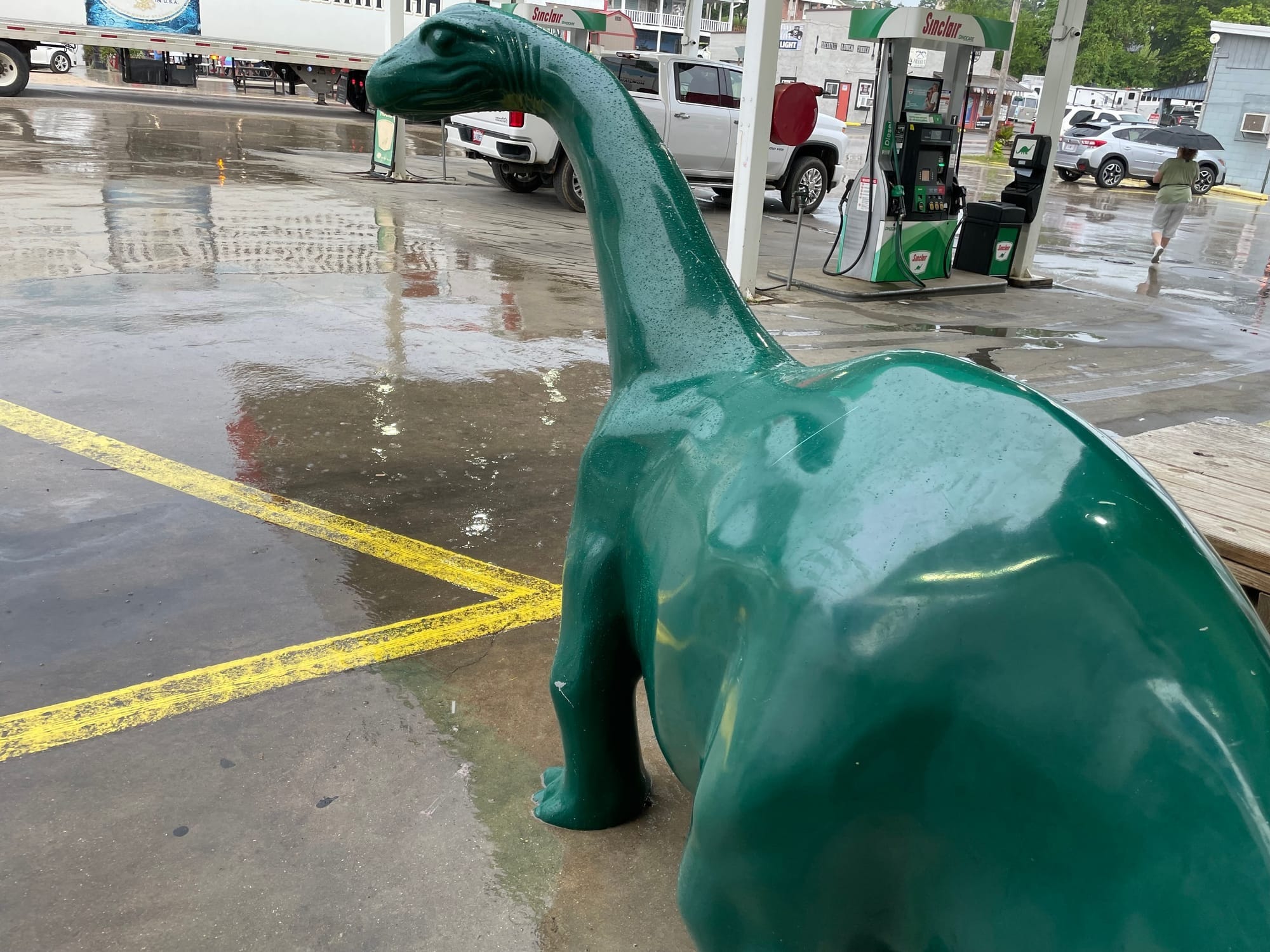This year marks a decade since 196 nations agreed in Paris to establish specific targets for reducing their greenhouse gas emissions. The goal was set at keeping the average global temperature rise to 2°C (3.6°F) compared with preindustrial times 150 years ago. They also agreed aspirationally to work at keeping the rise below 1.5°C (2.7°F).
At the heart of the agreement to make this happen are the NDCs, the Nationally Determined Contributions, each nation’s plans for emissions cuts. The Paris agreement calls for updating NDCs every five years. In Dubai at the COP28 climate summit in 2023, the assembled nations agreed that the third round of NDCs scheduled for adoption this year should set a specific target for cutting emissions by 2035, aligning them with keeping global warming to the 1.5° goal.
Achieving this would mean, according to scientists, that there can be no new fossil fuel projects. That’s not the path being taken by oil and gas companies, which are investing tens of billions in new exploration and production. Using their record-breaking profits, the top 23 producers are planning to invest 60% more on exploration in 2025 than they did last year. And they’re doing so after 2024 was the first calendar year in which the 1.5°C threshold was exceeded every month. Eighteen of the past 19 months were the hottest on record. That makes no never-mind when a fatter bottom line and executive bonuses are the chief concerns.
The deadline for submitting the third round of NDCs was Feb. 10. More than 180 nations missed it. But in a Feb. 6 speech in Brazil, which will host the COP30 climate summit in November, Simon Stiell, executive director of U.N. Climate Change, labeled the NDCs “among the most important policy documents governments will produce this century” and said “their quality should be the paramount consideration. So taking a bit more time to ensure these plans are first-rate makes sense.” He urged the late filers to present their updated NDCs by September so that they can be included in COP30 documents.
Right now, national pledges place the world on a trajectory toward a rise of 2.6°-2-8°C (4.68°-5.04°F). But, ghastly as that outcome would be, most nations aren’t on a path to fulfill even these subpar pledges.



In a press release, Climate Action Tracker, an independent government watchdog, took note of five of the 10 nations that have submitted their NDCs:
The UAE, Brazil, the US, Switzerland and New Zealand have all come up with 2035 targets that fall way short of what is needed to keep global warming to 1.5°C, underscoring an urgent need to revitalise global climate action [...]
"The public is entitled to expect a strong reaction from their governments to the fact that global warming has now reached 1.5° for an entire year, but we have seen virtually nothing of real substance," said Bill Hare, CEO of Climate Analytics, a Climate Action Tracker partner organisation.
“So far, governments haven't lived up to their promises made ten years ago — to bring the world closer to a pathway consistent with limiting warming to 1.5°C at the speed needed. The deadline they themselves set ten years ago needs to mark the beginning of a year that sees a marked turning point in government action."
Good luck with that “turning point.”
The U.S. NDC, adopted by President Joe Biden just weeks before Donald Trump lied the oath of office, calls for cutting U.S. emissions over the 1990 baseline by 61%-66% by 2035. But that’s moot since Trump has given the required one-year notice that the United States is withdrawing from the Paris Agreement, just he did when he was president the first time. He’s also rescinded $4 billion pledged to the Climate Green Fund, which provides money to developing nations to meet their climate-related plans. President Barack Obama promised $3 billion to the fund, and President Biden added $3 billion. But only $2 billion of that has been provided and the rest now won’t be. Thus, the wealthiest, second-highest greenhouse gas emitter on the planet is giving the middle finger to poor nations whose minuscule emissions have contributed little to the climate crisis.
Chloé Farand at Climate Home News reports:
David Waskow, of the World Resources Institute, reminded large emitters of their responsibility to “unveil bold new plans that offer a credible pathway to reaching their net-zero promises.“ “Weak plans mean a bleak future, plain and simple,” he said. [...]
Among the large emitters that have submitted plans, only the UK’s target to cut emissions by 81% by 2035 compared to 1990 levels is considered 1.5C-aligned by Climate Action Tracker.
However, none of them improved their 2030 objective “which on the one hand makes those 2035 targets less credible and on the other, makes limiting peak global warming to 1.5C ever more difficult,” said [CAT’s] Sonia Gonzales-Zuniga.
Ever more scientists are labeling the 1.5°C goal dead although some still hold out hope. But right now, since few nations are on course to fulfill their existing NDCs, we’re headed for a catastrophic 3°C (5.4°F) or more of temperature rise. Meanwhile, in America, we’re stuck with a bunch of leaders, government and corporate, who not only have no intention of making more emission cuts, they also are determined to retreat on gains already made and conceal data about the consequences of their actions.
Tick, tick, tick.
—Meteor Blades
WEEKLY ECO-VIDEO
RESOURCES & ACTION
- Top 2024 Victories for People and Planet to Inspire Next Year’s Activism. Across the globe, people took bold steps to care for the planet; 2024 showed us the strength of coming together with purpose and passion.
- Climate victories are happening even if they don’t make the headlines. Despite political setbacks under Trump, climate activists, local governments and legal victories worldwide are quietly driving environmental progress.
- Ten Grim Climate Scenarios When Global Temperatures Rise Above 1.5 Degrees Celsius
- Global Biodiversity Species Global Grid database, a World Bank project, includes over 600,000 species, including arthropods, mollusks, plants and fungi, across terrestrial, freshwater, and marine environments, alongside more traditionally-represented vertebrates (amphibians, birds, fish, reptiles, and mammals).
ECO-QUOTE
“Shhhh, I have a secret for you all. Capitalism and the fossil fuel industry are causing the climate crisis. Wait, is that not a secret? Then why are governments, private institutions, and multinational companies still investing billions of dollars in the very industry that’s causing the suffering of billions of people?”—Mitzi Jonelle Tan.
RESEARCH & STUDIES
- Petrochemical plants send millions of pounds of pollutants into waterways each year. Nearly 70 petrochemical companies across the nation are sending millions of pounds of pollutants into waterways each year due to weak or nonexistent regulations, according to a report published by the Environmental Integrity Project.
- Representing gender inequality in scenarios improves understanding of climate challenges says a report published at Nature Climate Change.
- Countdown to an ice-free Arctic: Research warns of accelerated timelines. Computer models were used predict when the first ice-free day could occur in the northernmost ocean. The researchers calculated that the first summer on record that melts practically all of the Arctic's sea ice could occur as early as 2027.
HALF A DOZEN OTHER THINGS TO READ (OR LISTEN TO)


Deb Haaland, America’s first Native Cabinet secretary, considers her legacy. Anita Hofschneider at Grist conducted an interview with the former Interior secretary, who has declared her candidacy for New Mexico governor. Here’s a short excerpt:
Hofscheider: What do you hope your legacy will be? What part of it are you most proud of?
Haaland: One of those pieces (of my legacy) is the Boarding School Initiative. Nothing had ever been done like that before. This was an era of American history that a lot of mainstream Americans didn’t know about. Indian Country knew about it, and it plagued us. It was generational trauma that so many tribal communities have suffered. But we brought attention to that. We will continue to shine a light on it. And I hope, in a way, that we’ve been able to bring about healing as a result of all of the work that we have done. [...]
Hofschneider: At the time that the Willow project was approved, news reports said it was a difficult decision for you to make. Looking back, what do you think about the approval of that project? Do you have any regrets?
Haaland: That was definitely a difficult decision — folks on one side of the issue and other people on the other side of the issue. I think that in the end, the people of Alaska spoke. This wasn’t a new project that just popped up during the Biden administration. There had been contracts that had been signed in years past. It had been going through this process for like 20 years. And so by the time it came to us, it was just really time to make a decision. And there were valid existing rights that we had to consider. We have laws in our country. Contract laws are our contract laws. And when people have valid existing rights, you have to consider those. In the end, I feel like we did what needed to be done at the time.
The Unavoidable Demise Of The Western Car Industry In China by Maarten Vinkhuyzen at Clean Technica. Now we have a new reality. The domestic new energy vehicle (the Chinese name for plug-in vehicle) makers are out-engineering those people from far away. Not only are the volume brands of VW, Nissan, Ford, Toyota, and GM, etc. losing market share fast, but Mercedes, BMW, and other premium brands are also unable to compete with domestic brands on quality, design, and price. Even Tesla, for a few years the leading new energy vehicle brand in China, is loosing a price war with BYD. The latest report of our specialist José Pontes tells us the current state of the Chinese market. How attractive will a cheaper but much better domestic product be in competition with inferior, expensive products from those invaders of the local economy? Yep, I am being sarcastic.
No other energy source came close to matching solar’s rate of growth in 2024—in numbers by Michelle Lewis at Electrek. Solar in the United States was 81.4% of new electricity-generating capacity during the first 11 months of 2024. According to FERC’s latest “Energy Infrastructure Update” report (with data through Nov. 30, 2024), 25.8 gigawatts of new utility-scale solar generation was placed into service in that period. (Note: the Trump administration has made content on the FERC website “unavailable.”) Utility-scale solar generating capacity has now reached 125.53 gigawatts or 9.61% of the total installed U.S. capacity from all energy sources. (FERC’s data do not include the capacity of small-scale solar systems that account for roughly 30% of all US solar capacity.) New wind capacity accounted for most of the balance through November—2.8 gigawatts (8.8%). Another 248 megawatts were provided by hydropower, geothermal, and biomass. Thus, the mix of all renewables accounted for 91.0% of all new capacity additions. The United States has about 1,300 gigawatts of generating capacity from all energy sources.
Related: China installed a record capacity of solar and wind in 2024 – in numbers and Global utility-scale solar additions hit 182 gigawatts in 2024


Pricey Dam Project 7 Years In The Making Finished By Beavers For Free by Hillary Hanson at HuffPost. Beavers have no regard for human laws, so even if they’d known that the construction of a dam in Czechia’s Brdy region had stalled due to permitting complications, they wouldn’t have cared. According to Radio Prague International, environmentalists had planned a dam in an area where, years ago, the military had built a drainage system. The new dam was intended to stop the drainage and create a wetland to revitalize the local ecosystem. The project had been in the planning stages for seven years, and was slated to cost the equivalent of $1.2 million, according to National Geographic. But as officials hashed out the details of securing the necessary permits, a local beaver colony took matters into its own paws, building a natural dam in the perfect location to create a thriving wetland for free. “Beavers always know best,” Jaroslav Obermajer of the Czech Nature and Landscape Protection Agency told RPI. “The places where they build dams are always chosen just right — better than when we design it on paper.”
The silent threat beneath our feet: How deregulation fuels the spread of forever chemicals by Paul Adepoju at The Revelator. The Trump administration has already rolled back planned limits on PFAS chemicals, which have been linked to cancer and other health problems. The water flowing from taps in Wilmington, N.C., looked clean, tasted normal, and gave no indication that it carried an invisible threat. For decades the Cape Fear River had provided drinking water to hundreds of thousands of residents in the region. But in 2017 tests revealed what many had feared: high levels of per- and polyfluoroalkyl substances (PFAS), chemicals linked to cancer, immune dysfunction, and reproductive issues, coursing through their water supply. The contamination had been traced to Chemours, a spinoff of DuPont, which had been releasing PFAS chemicals from its Fayetteville Works plant for years. The discovery sent shockwaves through the community, triggering lawsuits, emergency water-treatment plans, and a reckoning over how corporations and government regulators had failed to protect public health. But even as residents fought to hold polluters accountable, the company responsible for much of the contamination was tightening its grip on the agencies meant to regulate it.


U.S. Aid Agency’s Climate Programs Aimed to Curb Migration. Now They’re Gone by Christopher Flavelle at The New York Times. Two months ago, the Biden administration announced an initiative to share satellite data with Central American countries including Guatemala, Honduras and El Salvador to help them prepare for severe storms. The goal was twofold. In a region vulnerable to hurricanes and other calamities made worse by a warming climate, reducing the damage would help ease suffering. It would also relieve the pressure to migrate to the United States. And at $6.6 million, the project, run by the U.S. Agency for International Development and NASA, cost a tiny fraction of what the federal government spends on border security. That program, along with a suite of other development projects designed to reduce the flow of people from Central America to the U.S. border, now seems to be over. The day he took office, Mr. Trump signed an order freezing U.S.A.I.D. spending; on Friday, he proposed closing the agency entirely. The State Department has assumed responsibility for the agency, which is set to lose 97% of its staff.
WEEKLY BLUESKY POST

ECOPINION


Amtrak Isn’t Profitable — And That’s Okay by Jim Matthews at the Rail Passengers Association. As a for-profit company, Amtrak fails ... spectacularly. As a government agency, created half a century ago to carry out a public purpose recognized in law and in Supreme Court rulings, it is a spectacular success worth celebrating, supporting, and building up. Amtrak will never be a successful “company” in the traditional sense, and the leadership team is setting itself up for failure if it implies that Amtrak should be measured by that yardstick. If Amtrak tries to masquerade as a for-profit company, it diminishes the public policy purpose for which it was created and continues to be funded.
Putting communities at the heart of plastic pollution initiatives by Timnit Kefala at EHN. From the production of plastics to their fates in the environment, marginalized communities are most impacted. Petrochemical industries, which manufacture the building blocks of plastic, are disproportionately located near Black and Brown communities. Lower income areas within cities are more likely to face higher exposure to microplastic pollution, largely due to the density of less effective waste management systems, the omnipresence of plastic infrastructure in our built environment and reliance on plastic product use due to the distrust of the physical infrastructure that delivers environmental goods, like potable water. When thinking about how to mitigate the harm from microplastics, I found that proposed solutions were always at the discretion of the plastic consumer, rarely the producer or regulatory entities, with messaging like using a reusable water bottle, eating less processed food or buying clothing with natural fibers. But a lot of reusable alternatives or solutions are suitable for people who can afford them and trust the delivery of public goods.


Trump’s agenda won’t let his energy secretary achieve ‘energy abundance’ by Gautama Mehta at Grist. Wright’s commitment to energy abundance stands in contrast to the agenda, augured in Project 2025, that seems to underlie Trump’s executive orders so far, which would make it very difficult for Wright to act on his stated priorities of increased energy supply and funding for research and development.Trump started off his second administration by declaring an “energy emergency” — but followed this up by unilaterally freezing all new permitting and leasing for wind energy in federal lands and waters. The president also has attempted to freeze many federal grants and loans. And Trump’s blanket freeze of foreign aid has already gouged the administration’s ability to make good on Wright’s vision of helping the developing world electrify: Programs like Power Africa, which directed USAID funds toward ending energy poverty in Africa may have already been halted. The president’s moves raise the question of how exactly Wright, as energy secretary, can ensure “energy abundance” if his boss isn’t on board.
Which LA Fire Victims Get Money on GoFundMe — and Who Gets Left Out? by Jonah Valdez at The Intercept. Over the past five years, GoFundMe has also seen a 90% increase in disaster-related fundraising. The platform, however, is also rife with inequality. A growing body of research has shown that GoFundMe amplifies existing biases within aid and, in some cases, exacerbates them. Its fundraisers tend to favor wealthy and highly educated people, according to such studies. Individuals who reach their fundraising goals are often those who need it the least. About 40 percent of all campaigns related to the pandemic didn’t raise any money at all. White campaigners tend to get more money than their counterparts who are Black or Hispanic. Mai-Lin Graves and Cierra Black hope their fundraising campaign can push back on racial disparities and also America’s neoliberal views on charity, which focus on the individual over the collective and trust the free market above all else.
State-Based Clean Car Rules Save Money and Save Lives by David Reichmuth at the Union of Concerned Scientists. President Trump issued an executive order that calls for the EPA to terminate the waiver granted late last year that allows California to set clean car rules that are more protective than the national standards. The legality of this planned move is murky, and the administration still needs to go through procedural steps to finalize it, but the benefits of the state-based regulations now under jeopardy are clear: thousands of dollars of savings for vehicle owners, almost 400 million metric tons of greenhouse gas pollution reductions in California alone, and thousands of avoided ER visits and premature deaths due to lower exposure to air pollution.
OTHER GREEN STUFF
EV Battery Degradation Just Isn't Much Of An Issue • Mayors Across US Urge Congress Not to Repeal Clean Energy Tax Credits • Pennsylvania’s New Energy Plan a ‘Betrayal’ to Those on the Front Lines, Critics Say • Brazil has seen a 460% increase in climate-related disasters since the 1990s • Ford CEO says 25% tariff on Canada, Mexico would 'blow a hole' in US auto industry











Comments
We want Uncharted Blue to be a welcoming and progressive space.
Before commenting, make sure you've read our Community Guidelines.